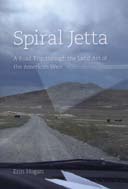Spiral Jetta Author Explores “Land Art”
 Erin E. Hogan ’88 was determined to do something out of the ordinary with her vacation time. Ultra-urban, mostly confined in her travels to the area apartments of friends, and quite possibly staring at an early midlife crisis, she set out from Chicago in her Volkswagen Jetta to see the poles, rocks, tubes, and gashes that make up the American land-art movement.
Erin E. Hogan ’88 was determined to do something out of the ordinary with her vacation time. Ultra-urban, mostly confined in her travels to the area apartments of friends, and quite possibly staring at an early midlife crisis, she set out from Chicago in her Volkswagen Jetta to see the poles, rocks, tubes, and gashes that make up the American land-art movement.
Director of public affairs at the Art Institute of Chicago and with a PhD in art history, Hogan had long been interested in seeing these massive earthworks that were created in the 1970s and 1980s and situated in the desert West. From Robert Smithson’s coil of rocks, Spiral Jetty, in Utah, to Michael Heizer’s half-mile-long notches set into a mesa, Double Negative, in Nevada, she traveled miles of dusty, dry roads to get to Walter De Maria’s 400 stainless steel poles, Lightning Field, in New Mexico and finally to Donald Judd’s 100 untitled works in milled aluminum in Texas.
The monumental creations were made in response to traditional spaces the artists considered confining and over-commercialized. Consequently, the works both taunt and beg visitors to find them, and then to embrace their shifting composition. Hogan wrote Spiral Jetta: A Road Trip Through the Land Art of the American West to share criticism of the art written by others, as well as her own understanding; her personal awakening is a narrative bonus.
“I was really interested in the way that land art transforms your sense of space,” says Hogan on the phone from Missoula, Montana, where she is attending a university conference on art and place. She has long been a fan of minimalism for its reorganization of space, and thought land art would also offer a different understanding of the body in relationship to the landscape.
What she found was something altogether different. “It didn’t have as much to do with space but [instead] with time,” she says of her experience with Lightning Field in particular. “You have to spend twenty-four hours there [in a cabin with strangers] and you have to live through all the cycles of light on this particular work. It was being attentive to that over twenty-four hours that finally had that sort of transformative effect on me.”
Artistic insight often edged over into personal understanding. When she toured Marfa, the multi-structure art mecca in Texas where Donald Judd’s work is displayed, she once again realized that the work was not about objects in space but “time and change and having a fixed place that the universe revolves around. I had always thought [the fixed place] was me; but these works were that fixed place.”—M.H.B.
May 7, 2012







Leave a Reply